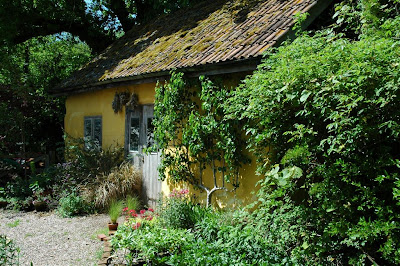The first garden trip of the year was to England at the end of May, and included some highlights I have already posted about, such as the 2010 Chelsea Flower Show and The Lost Gardens of Heligan in Cornwall. The main part of the trip was spent in Devon though, where the first garden on the agenda was Holbrook. As one of the few new perennial gardens in the Devon area, and actually all of England, I clearly couldn't miss this one, especially when it's recommended by Noel Kingsbury as “one of the best examples of ‘New Perennial’ planting in Britain”.
Holbrook is a rather small, private garden with a nursery attached. It tries to pack in a lot of habitats, betraying a bit of the English plant collector spirit. There are dry, wet, and damp meadows, woodland edge, a pond, veggies and some chickens. The garden philosophy is firmly rooted in naturalistic ideas, with plantings designed to evoke natural plant communities. The owner’s inspiration comes from German naturalistic gardens, but I was also reminded of Dutchman Henk Gerritsen's garden – similar to his Priona garden, this garden also feels really relaxed and at peace with nature, although the design approach is quite different.

The first area close to the house is an open, dry prairie-style stone garden where the owners are experimenting with hot climate plants in strong colours. One unfortunate disadvantage of our visit was the timing – late May is not the peak of this garden area. It’s designed for fireworks in late summer. There were still some nice plants in bloom though, and some grasses were already making an impact. This area was quite small for a meadow planting, so I would have been interested to see how well it works at its peak. There are some beautiful pictures on the website to suggest it does succeed quite spectacularly.




Further down, the stone garden transitions to the wildflower meadow and woodland. Transition areas where you move from open sunlight to shade and enclosure often create some of the best effects in a garden.


On to the woodland area, which I thought was the most successful in the garden, though this may have been biased by the timing of our visit (although most early flowering wildflowers and shrubs were past). The relaxed and comfortable feel in this garden area fit perfectly with the domesticated English countryside where Holbrook is located - soft, un-cut grass, dotted by small woodland edge trees letting through filtered sunlight, larger oaks in the background, and a small stream on the boundary. Perhaps this may not be as exciting to the owners as some more innovative prairie and dry plantings, but as a visitor this felt like the most comfortable planting.





The pond with the surrounding marshy plantings took up the center of the garden, and like the woodland, fit very comfortably in its site. The wet meadow surrounding it was much further along than the prairie garden, although the full peak of this area is probably also right about now.

Overall, this garden had a lovely feel to it, and some nice naturalistic plantings. I do wish I would have seen the full climax of the meadow plantings, to better learn from the planting style and to see exactly how well they work in a small space divided in so many habitats.

No comments:
Post a Comment